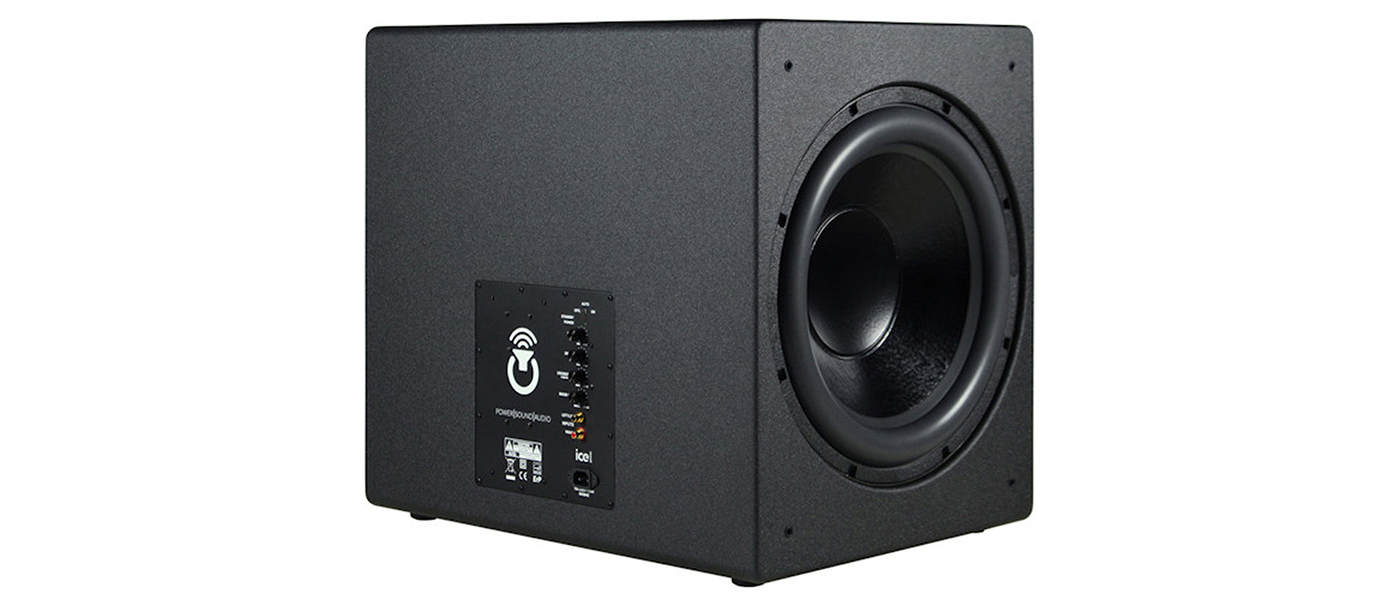It takes the same horizontally-opposed, dual-active/dual-passive driver arrangement of the larger SuperSub XXL model and reduces it to more Lilliputian dimensions. I had reviewed the SuperSub XXL last year and found it to be a modestly sized but potent performer of a subwoofer. The SuperSub X aims to bring similar levels of “Boom” to places where space is at more of a premium. Can you say Napoleon Complex?
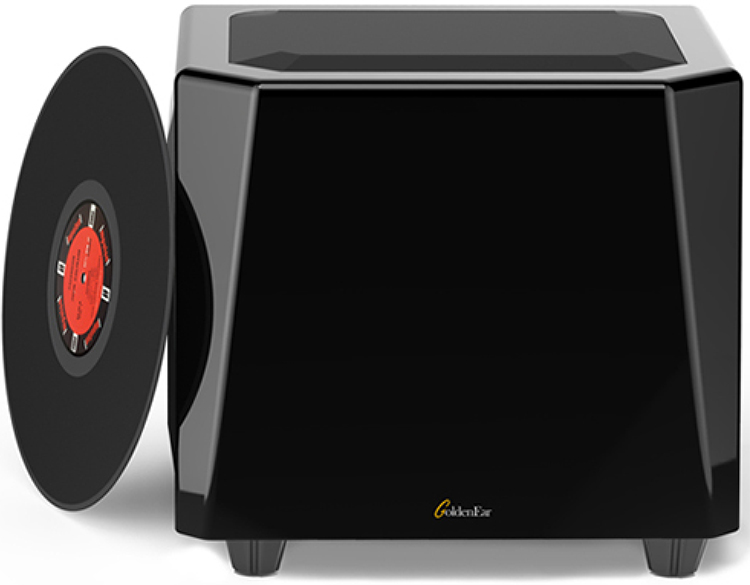
GoldenEar Technology SuperSub X Subwoofer
- Potent, clean, and detailed bass reproduction for both movies and music.
- Strong in-room response down to almost 20 Hz.
- One sub can energize a small to medium sized room.
- Compact size allows for easy integration of multiple subs.
- Patented use of dual opposed drivers on the horizontal axis and dual opposed passive radiators on the vertical axis.
- May require a little extra care in placement for optimum results.
How does one improve on a good thing? By making it bigger? Perhaps – although not necessarily in this particular case. On the heels of the successful launch and reception of their SuperSub XXL subwoofer, GoldenEar has apparently begun putting a few of them through some sort of shrink ray back at headquarters to get the almost identical looking, but smaller, SuperSub X. It uses the same “Dual-Plane Inertially Balanced” design as the larger XXL model but with smaller drivers and passive radiators in a more diminutive clone of an enclosure. At first blush this may look like an answered prayer for apartment dwellers or anyone whose home theater space is at a premium. Does it give up much to its bigger brother in the “oomph” department? Well now, let’s take a closer look shall we?
Design:
Dual-driver subwoofer with dual passive radiators
Drivers:
Two 8” long-throw high-output bass drivers (horizontally opposed)
Two 10 ½” x 9 ½” quadratic planar infrasonic radiators (vertically opposed)
Frequency response (manufacturer):
12 Hz-250 Hz
Amplifier:
1400 Watt ForceField Digital/DSP Amplifier
Low Pass Filter:
12dB per octave continuously variable from 40Hz-150 Hz. for Stereo Inputs
Inputs:
Direct Coupled, unfiltered LFE -input / Low Level Left and Right channel inputs
Dimensions:
12 ¾” (32.4 cm) H (w/feet) x 14″ (35.6 cm) W x 13 1/4″ (33.7 cm) D
Weight:
31 lbs.
MSRP:
$1249.99
Company:
SECRETS Tags:
GoldenEar, Subwoofer, Passive radiators, Compact subwoofer, Subwoofer Reviews 2016
Where to Buy:

“Honey! I shrunk the GoldenEar SuperSub XXL!” That’s the first thing that came to mind when I unpacked the new SuperSub X. While smaller in size to its bigger brother, the new sub looks for all the world, aesthetically identical. That also includes the same robust build quality and piano-black-finished medite MDF enclosure.

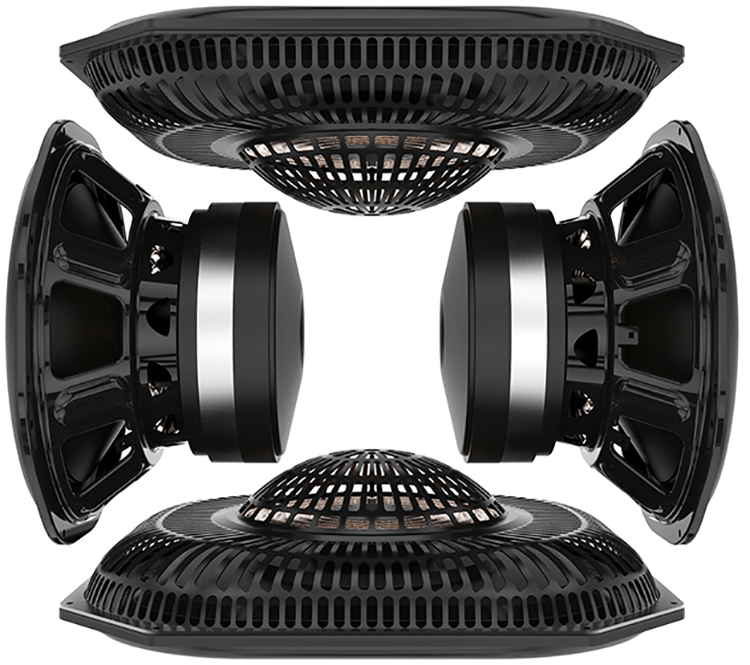
From a technical standpoint, the SuperSub X sports two 8” long throw bass drivers which are mounted in a horizontally opposed configuration so that they fire out the left and right sides of the enclosure. In addition to these active drivers, GoldenEar couples two larger oblong passive radiators, also in a horizontally opposed setup, firing out of the top and the bottom of the box. This driver and drone arrangement is said to have a couple of major benefits. The first being that any inertial forces from the operation of a single driver, which would normally be transferred to the box as wasted energy, get cancelled out by the other driver as they are both moving in phase. This has an additional benefit of contributing to the inertness of the enclosure. The second is that because there is sound radiating from four different axis, the SuperSub XXL should have a better time coupling with the room and, subsequently, have a smoother overall response. While active driver/passive radiator subwoofer designs are nothing new in audio, GoldenEar’s implementation of this concept seems notable enough to have warranted being recently granted a US patent (US 9,462,391 B2) on their SuperSub designs. The subwoofer’s electronics package consists of a 1400 watt class D amplifier controlled by a 56 bit processer section with a 192 kHz sampling rate.
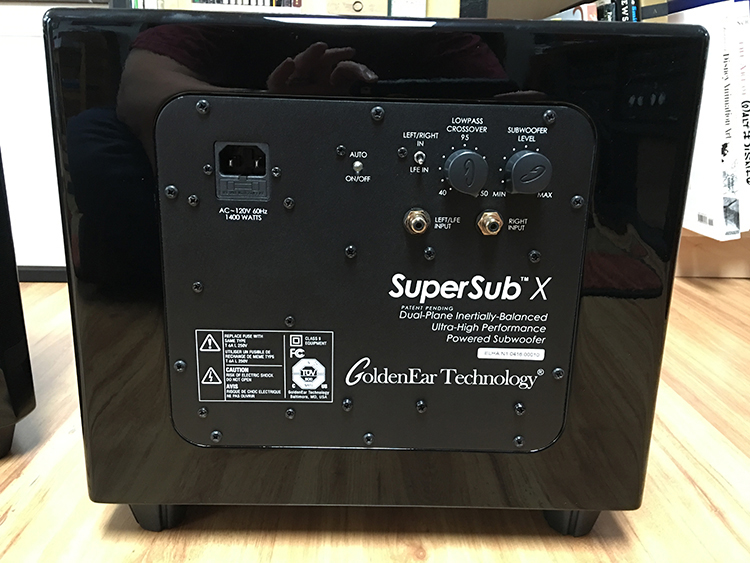
On the back of the subwoofer, we find the main inputs and controls. There is no ON/OFF switch as the subwoofer is auto signal sensing so only a blue status light indicates a state of activity. To the right of that is a toggle switch to select either LEFT/RIGHT or LFE input. Beside this are two rotary dials, one for setting the Low Pass Crossover frequency and the other for setting the overall level. Right below these dials are a pair of LEFT/RIGHT RCA input jacks. The LEFT jack also doubles as the LFE input and is switchable via the aforementioned toggle switch.
For most my testing, a single subwoofer was used in my home theater and set up along the side wall, nearest to the front right speaker which is not a traditional or textbook location. In my room, I found that this sub didn’t seem to like the normal spot that I usually locate subwoofers (front wall behind the front right or left speaker). After a bit of experimentation, I found that the SuperSub X seemed to prefer a side wall placement. This is the same situation that I experienced when testing the XXL last year. That location seemed to result in the best coupling with the room and the smoothest raw overall response before any speaker calibration was applied. Of course, every home theater is different so optimal placement will vary room to room. It is therefore always wise to take the time to try different locations when placing a sub. The well written owner’s manual also gives some good suggestions of where to start. GoldenEar was nice enough to send two identical subwoofers as I usually run twin subs in my home theater to help even out the bass response amongst all the seats. So, after all the preliminary testing and measuring was done I incorporated the second subwoofer into the system. The size of these subwoofers almost beg for them to be used in multiples.
Secrets Sponsor
Associated equipment used: Anthem MRX 1120 receiver, OPPO BDP-103 Blu-ray player, Salk Songtower main speakers, Zaph Audio ZD3C center channel speaker, Rocket RS300 quasi-dipole surround speakers, Pioneer 50” KURO plasma display.
So, having gone through a similar setup experience already with the SuperSub XXL, I found that the X benefitted from the same placement methodology and, for the most part, it gave me very similar results to the XXL. When you are dealing with subwoofers, the overwhelming temptation is to judge it primarily on how low a frequency it will reach and the level of output it will generate. But there are always other considerations to take into account as well. Like any other speaker type out there, a subwoofer should sound good and have a certain level of accuracy with whatever content you play through it, music being especially critical. Marketing claims aside, in practice GoldenEar subwoofers have never been sub-20 Hz bottom feeders, at least not in my rooms. What they all have been though is exceptionally great sounding, and highly accurate with the kind of material, and at the real-world levels that I listen. And they seem achieve this (throughout their products, mind you) by using well established design principles and theory, but applied in a more unconventional manner. It’s one of the things that, as a reviewer, makes GoldenEar’s products interesting and, frankly, a lot of fun to mess around with. In the SuperSub X what we essentially have is a clean sounding and accurate bass producer that will couple really well with a room and deliver very smooth response down to about 20 Hz, at above average levels. Sounds good but not exactly earth-shattering, until you see that this all comes out of something the size of your average microwave oven. Combine that with a fine furniture level of finish with a decidedly Art-Deco bent to its design and now you’ve got something with a whole different level of appeal than your average big box with a driver and an amp.
Secrets Sponsor
So, with setup done and room correction run (Anthem’s ARC in this case) serious listening could now properly begin. My initial listening impressions were that a single SuperSub X did an excellent job filling my medium sized home theater with appropriate levels of bass and a very even level of coverage, coming very close to what the XXL did. Like other GoldenEar subwoofer offerings, the SuperSub X excels at detail retrieval in the lower registers. When especially listening to music, you really start to notice the different pitches down in the low end more. No, you will not feel that 16 Hz organ pedal from your demo disk, but everything else from the low end of said organ will sound very fine! Plucks of a standup bass, a piano hammer hitting a low A, and kick drums all seemed to deliver a clearer sonic story versus the typical “thump, thwack, or thud” from some other subs I’ve heard. And while it does distinguish itself at the presentation of the subtleties, this sub will hit solidly when you ask it to.
When I eventually added the second SuperSub X into the mix, positioning it directly across from the first one on the other wall, things just got even better! With more headroom at my disposal, everything just became more impactful. The bass also became more even from seat to seat in my home theater, with a good deal less variation when I moved around. My wife was impressed at the levels of bass coming out of this comparatively teeny box. She appreciates good sound, but always likes it when we can see more of our room and less of the equipment. Even with two SuperSub X installed, she was actively considering how to decorate all the newly freed space in my HT. I think people with limited space considerations or who are looking for a more unobtrusive installation are going to find a hell of a lot to like about this product. A few of the standout music and movie samples during my time with the SuperSub X were:
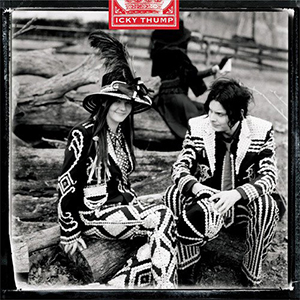
Icky Thump by The White Stripes on Warner Brothers CD. The last studio album from The White Stripes is a blistering return to their garage rock and blues roots. While the CD has a bit of a rap for being mastered at an excessive volume, the resultant distortion fits in well with the overall sound of the album.
Meg White on drums is outstanding and every distorted kick drum hit comes through on the little SuperSub X with a good deal of power and authority. The title track, “Icky Thump,” and the song “Conquest” just have a great driving rhythm to them and the SuperSub X showed that it had all the guts it needed to properly rock out with these tunes. It’s loud, dirty, punch-in-gut music that sounds really good through this sub.

It Happened One Night 6.28 by Holly Cole, Metro Blue CD. This is a disk that I come back to often because it is such a great live recording with fantastic bass, piano and percussion to augment Holly Cole’s magnificent vocals. The opening track, “Get Out of Town” starts with some low register piano notes that come through properly weighted via the SuperSub X.
The song then transitions to a mini bass solo with such a deep and tight attack on the strings that translates just about perfectly through the X. “Cry If You Want To” also has a great dueling stand-up bass and drum part, about half way through the song, that features the SuperSub X interpreting all the deep characteristics of those two instruments cleanly, potently and accurately. The detail reproduction is pretty much as good as I remember it being from the XXL model.

Captain America Civil War, Marvel Studios. The third installment in the “Cap” franchise sees a long building turmoil come to a head between Captain America and Iron Man, as well a good deal of setup taking place for the next Avengers movie. The SuperSub X lived up to its billing by keeping up with all the superheroes in this movie and all the super-effects from the super-powers that required some super-amounts of bass playback. One of the best scenes was when the Avengers are squaring off against each other at the airport and Ant-Man has turned himself into a literal giant as a diversion for Captain America and Bucky to escape.
Ant-Man’s enormous foot falls, various explosions, impact crashes, super power sounds and, just general, bass-churning mayhem in this scene was like playtime for the little GoldenEar. While perhaps just a shade less potent than its bigger brother would’ve been, the SuperSub X, nonetheless, gave a most enjoyable performance here. For such a modestly sized little box, I just had to be impressed with how big it sounded and how well it meshed with all my other HT speakers at the crossover point.

In the Heart of The Sea, Warner Brothers. This movie tells the tale of how Herman Melville found the inspiration for writing his great American classic, Moby Dick. The story centers around the characters on board the whaling ship Essex and its ill-fated encounter with a “demon” of a white whale. Soon after the movie begins, the ship’s captain sends the Essex directly into the path of a huge storm as the crew tries to make up lost time to get to the whaling grounds.
The SuperSub X does yeoman’s work in helping to engross you with all the power of the sea. The waves crashing into the ship during the squall felt thoroughly weighty and deep, and any time the point of view became submerged, the GoldenEar helped make you feel the weight of the ocean upon you. Later in the film, when the white whale shows his displeasure with the sailors by physically ramming the Essex repeatedly, the SuperSub X was, once again, punching above its weight making each one of those impacts feel forceful and solid. In fact, any time the camera placed us near the demon white whale, the LFE effects made you feel like you were indeed next to something truly massive. Again, this is pretty impressive stuff coming from one subwoofer about the size of a home bread machine.
The benchmark tests were conducted through the subwoofer’s RCA LFE input. The source device was a LYNX Two professional PC sound card using test signals created by SpectraPLUS audio measurement software. Measurements were sampled with a calibrated Earthworks M30 microphone. Subwoofer frequency response measurements are close mic’d at 1 foot from the center of the driver. All THD+N tests are conducted with the mic at 2 meters. Except where noted, the subwoofer was measured indoors in the center of a large basement room with a minimum of 5 meters to any wall. All measurements were taken with the mic and software calibrated at 90dB
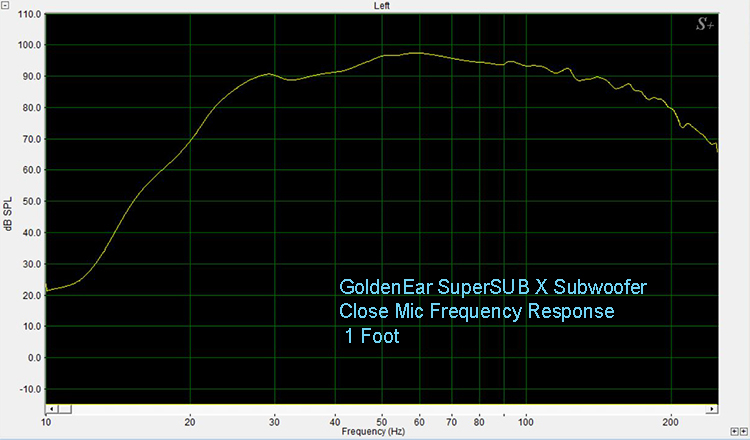
This is a frequency response measurement taken of the SuperSub X using a 10Hz – 250Hz sweep. It is meant to simulate an anechoic response (as much as is reasonably possible here) without the benefit of notable room gain. Since this sub has four radiating surfaces, measurements were taken at 1 foot from the center of each surface and averaged together to create this graph. The sub has a pretty nice response down to about 26 Hz before it starts to quickly roll off. No doubt some protection measures are in place here to protect the driver and amplifier from damage below the passive radiators tuning point. The unassisted results are nice and consistent without any anomalies between the amp and drivers.
This next graph shows THD+N measurement at 50Hz to be 0.695315%. A very good figure.
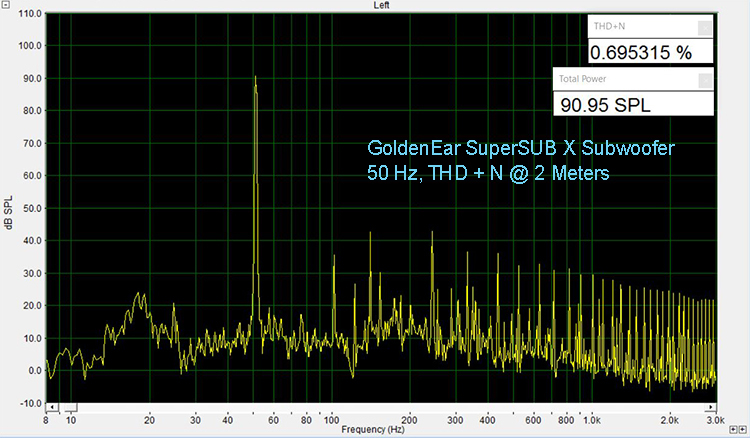
Next is the THD+N measurement at 40Hz which is 0.760667%. Also, an excellent figure.

At 30Hz the THD+N figure is 0.861524%. Very good.
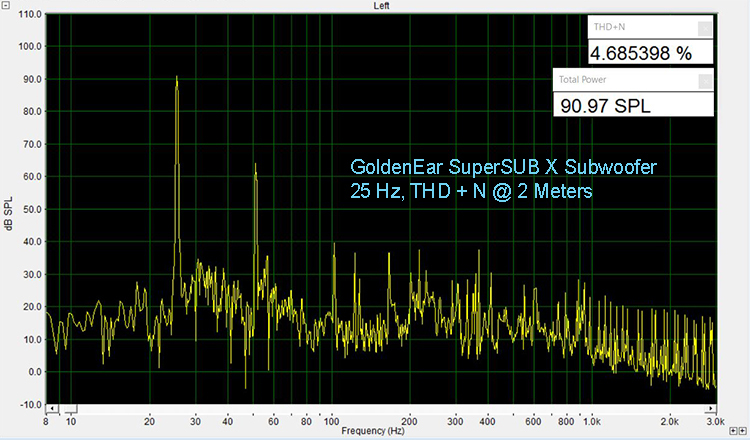
At 25Hz we see a bit of a jump in distortion to 4.685398% THD+N. Still, not too bad and below audibility.
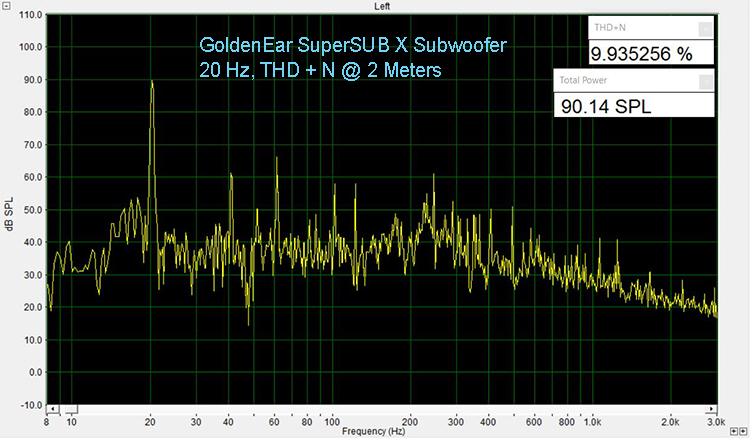
At 20Hz the THD+N level rises again to 9.935256%. 10% THD+N is considered the level where distortion starts becoming audible in the bass frequencies.

This a plot of ARC’s measurement of the SuperSub X in my HT. Note the purple “uncorrected response with bass management” line which shows the effect of room gain on output and extension in the lower frequencies versus the “anechoic” frequency response graph earlier. This gives ARC plenty of room to work with in helping to set a flatter extended target. It’s also a truer representation of how this sub will perform in-room.
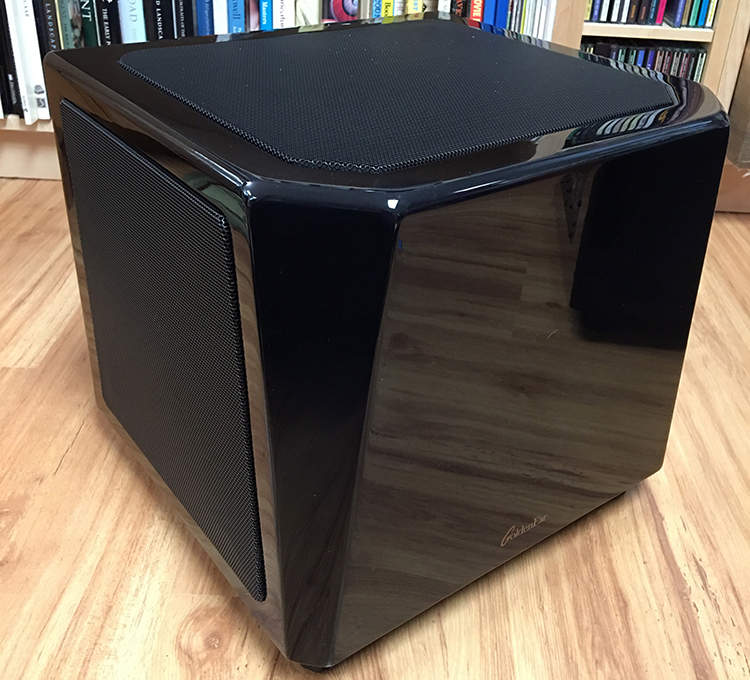
THE SUPERSUB X is a Sleek Cat of a Subwoofer That Roars Like a Lion.
- Excellent sound quality.
- It’s small.
- Solid construction.
- Attractive finish.
- A 0/180-degree phase switch or variable phase control for those who don’t use room correction.
- A balanced (XLR) input.
- Other finishes beyond piano black.
The GoldenEar SuperSub X is an excellent little subwoofer, full stop. It gives one a large measure of the performance available from the bigger sibling XXL model, but in an even more petite package. GoldenEar has used some novel thinking and engineering design work to obtain the performance parameters of a traditionally larger sub from something small enough to make deep bass accessible for people who might be otherwise space-challenged. It’s built robustly, looks fetching and, where it counts, sounds extremely good. On music, in particular, GoldenEar subs have been exceptional performers and the SuperSub X is no different. One of these subs will convincingly energize a medium sized room. If you get two, and take the pains to place them properly, you will be rewarded with more headroom and more even bass distribution. I’m a firm believer in the benefits of multiple subs so I like to encourage this line of thinking. The SuperSub Xs are so small however, why stop at only two? Go for four. I’m sure GoldenEar won’t mind!


